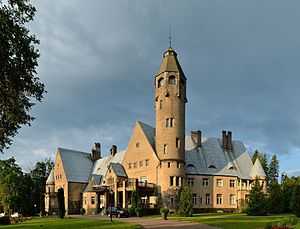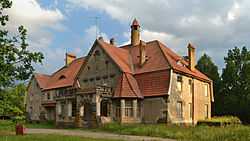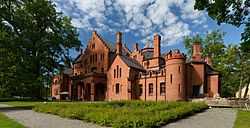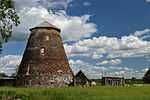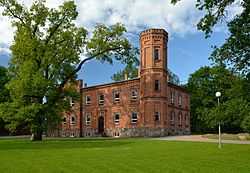Valga County
| Valga County | |||
|---|---|---|---|
| County of Estonia | |||
|
| |||
| |||
 | |||
| Country | Estonia | ||
| Capital | Valga | ||
| Government | |||
| • Governor | Margus Lepik | ||
| Area | |||
| • Total | 2,043.53 km2 (789.01 sq mi) | ||
| Population (Jan 2014[1]) | |||
| • Total | 30,176 | ||
| • Density | 15/km2 (38/sq mi) | ||
| ISO 3166 code | EE-82 | ||
| Vehicle registration | G | ||
| Website |
www | ||
Valga County (Estonian: Valga maakond), or Valgamaa is the first-level administrative unit in Estonia and one of 15 counties of Estonia. It comprises the former area of Valga District. The present-day county was created on the 1st of January, 1990. The capital and the biggest town of Valga County is Valga, followed by Tõrva and Otepää. It is situated in southern part of the country and borders Põlva County and Võru County to the east, Latvia to the south and to the west, Viljandi County and Tartu County to the north. 30,176 people live in Valga County (as of January 2014).
General
Valga County islocated in the southern part of Estonia. By the economic-geographical and regional-political distribution it belongs to the area of South-East Estonia (together with Põlva and Võru County). By historical ties and landscape the county belongs to the region of South Estonia (together with Põlva, Võru, Viljandi, Tartu and Jõgeva Counties). The total area of the county is 2,043.53 km² (2,046.49 km² together with the area of Võrtsjärv), with the population of 30,176 people (as of 1 January 2014), it reaches the north-south direction of 65 km and east-west direction of 59 km. Valga County ranks the 12th in Estonia by population and the 14th by the area.
The distances from the county centre, Valga, are the following: Tallinn 267 km, Tartu 86 km, Viljandi 88 km, Võru 73 km, Põlva 96 km, Pärnu 141 km, Narva 264 km and Riga 157 km.
Valga County borders with Viljandi County in the north-west, with Tartu County in the north and Põlva and Võru County in the east. Valga County has a borderline with the Republic of Latvia in the south and west (102.4 km).
History
Medieval Period
It can be read from the Livonian Chronicle of Henry that the history of the county goes back to the 13th century when the Germans conquered the settlement. By the Chronicle the River Ümera was the borderline between Estonia and Latvia. Historians suggest that the River Säde was the borderline, flowing through the northern part of Tireli Bog and falling into Lake Burtnieks. Meadows and forests surrounding the big Tireli Bog and the upper stream of the River Säde were probably even wider and impassable at that time and therefore functioning perfectly as a border.
The ancient (13th century) national border ran in a totally different place. Assumably the area of Härgmäe belonged to Estonian settlements and the national border went from the springs of the River Säde, passed the forests until the northernmost oxbow of the River Koiva and onwards alongside the river. Most likely the area of Kaagjärve and Valga Town belonged to ancient Latgalians.
After the crusades and the Ancient Freedom Fight in 13th century, Valga County became a natural centre of the historical Old Livonia where the most important roads from north, south and east went through, gaining strategical importance.
Early Modern Period
On the 3rd of July, 1783, the Empress Catherine II established a new administration order in the Baltic provinces. A new kreis (county), Valga Kreis, was constituted mainly from the territories of Riga and Võnnu Kreises. Valga Town which formerly belonged to Riga Kreis, went over to Valga Kreis. Valga Kreis consisted of eleven parishes, nine of them located on the present Latvian territory, and just two – Luke (Lugaži in Latvian, Luhde in German) and Härgmäe (Ērģeme in Latvian, Ermes in German) – had an edge on the present Estonian area, mostly near Valga, which became an attraction centre of the new kreis. City rights were given to Valga by a Polish King Stefan Batory in 1584.
In 1789, there were 891 citizens in Valga. As Valga became the centre of the kreis, St John´s Church was founded and also the building of kreis institutions was built in 1783-1786 (later it became a prison).
Recent history
On the 12th of February 1919, the Government of the Republic of Estonia issued a regulation of constitution of Valga County, consisting of the territories gained during the Estonian War of Independence. Several parts of Võru, Tartu and Viljandi Counties were close to Valga from the other side. On the 19th of April the first county governor was elected – Johann Kurvits, a farmer of Karula. He held this position until July 1921, when August Sild followed his position.
Until 1920s the surroundings of Härgmäe and Valga belonged to the mixed area of Estonia-Latvia as there was no exact national border. Half of the citizens were Latvians, the other half were Estonians. In 1920 the national border was fixed and that helped to differentiate between the nations. Valga Kreis was divided so that Estonia got the areas of Paju and Sooru Manors and the majority of Valga (where the citizens were mostly Estonians), the rest belonged to Latvia.
Independence
Valga County, almost in its present shape, was formed on the 6th of September, 1920 when the course of the War of Independence and the situation of those days required Valga to be separated from the other counties.
On the 11th of February, 1921 the Estonian Government fixed the area of Valga County. Võru County gave Kaagjärve, Karula, Laanemetsa and Taheva Parishes, Tartu County gave Tõlliste, Laatre, Sangaste, Keeni and Kuigatsi Parishes, Viljandi County gave Jõgeveste, Patküla, Koorküla, Taagepera, Leebiku, Helme, Lõve and Hummuli Parishes. Later on, several administrative territorial changes were carried through. In 1921 Patküla Parish was separated from Holdre Parish and Tõrva Borough. Puraküla, which formerly belonged to Paju Parish was united to Valga in 1922. In 1924 Paju Parish was united to Sooru Parish and on the 2nd of July 1926, it started to bear the name Tõrva. Since the second half of 1920s until 1939 there were 19 parishes in Valga County.
In 1939 many smaller parishes were united by the administrative reform. Ten parishes were left: Helme, Hummuli, Kaagjärve, Karula, Kuigatsi, Põdrala, Sangaste, Taheva, Tõlliste and Vaoküla.
World War II and occupation
The last pre-occupation County Governor Värdi Vellner had to give up his power on the 8th of July 1940. Nevertheless, the administrative division of 1939 lasted until 1950 when 39 county districtswere formed. They were divided into 636 village soviets.
The present territory of Valga County was divided into three parts: Valga, Tõrva and Otepää Districts. In 1952 the oblasts of Tallinn, Tartu and Pärnu were formed on the territory of the Estonian Soviet Socialist Republic.
In 1959 the liquidation of smaller districts began. Antsla, Otepää and Tõrva Districts were liquidated. Tõrva and the village soviets of Haabsaare, Helme, Koorküla, Mõniste, Riidaja and Taagepera were united to Valga District. Otepää Town and the village soviets of Otepää and Pühajärve were united to Elva District. In 1961 Mõniste was united to Võru District.
Next year, in 1962, Otepää and village soviets of Aakre, Otepää and Palupera were reunited to Valga District. One year later some areas of Põlva District were united to Valga District. In 1966 the area of Valtina was added and thus the final border of Valga District was fixed.
In December 1989 the Chairman of the former Executive Committee of Valga Disrict, Uno Heinla, was elected to be the first county governor after Estonia had regained its independence. On the 22nd of February 1990 the RSN Executive Committee of Valga District was reorganized and it became Valga County Government.
Regaining Independence
From the 1st of January 1999 there are three bigger towns in Valga County: Valga, Tõrva and Otepää. There are 11 parishes: Helme, Hummuli, Karula, Palupera, Puka, Põdrala, Otepää, Sangaste, Taheva, Tõlliste and Õru.
County Government
The County Government (Estonian: Maavalitsus) is led by Governor (Estonian: maavanem), who is appointed by the Government of Estonia for a term of five years. Currently the Governor position is held by Margus Lepik.
Municipalities
The county is subdivided into municipalities. There are 2 urban municipalities (Estonian: linnad – towns) and 11 rural municipalities (Estonian: vallad – parishes) in Valga County.

Urban municipalities:
Rural municipalities:
- Helme Parish
- Hummuli Parish
- Karula Parish
- Otepää Parish (includes the town of Otepää)
- Palupera Parish
- Puka Parish
- Põdrala Parish
- Sangaste Parish
- Taheva Parish
- Tõlliste Parish
- Õru Parish
Geography
References
- ↑ "Population by sex, ethnic nationality and County, 1 January". stat.ee. Statistics Estonia. 1 January 2009. Retrieved 2009-10-18.
External links
- Valga County Government – official website
- Valgamaa – official website (Estonian)
| ||||||||||||||||||||||||||||||||||||||||||


